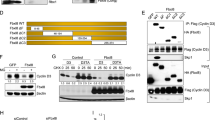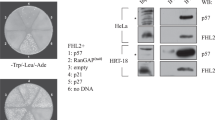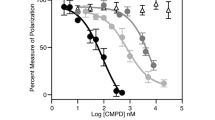Abstract
Acute promyelocytic leukemia is associated with chromosomal translocations that involve the RARα gene and several distinct loci producing a variety of fusion proteins. One such fusion partner is promyelocytic leukemia zinc-finger gene (PLZF), a member of the POK (POZ and Krüppel) family of transcriptional repressors that is a key developmental regulator, stem cell maintenance factor and tumor suppressor. Overexpression of PLZF has been shown to induce cell cycle arrest at the G1 to S transition and repress the expression of key pro-proliferative genes such as CCNA2 and MYC. However, given this data suggesting an important growth inhibitory role for PLZF, relatively little is known regarding regulation of its activity. Here we show that the main cyclin-dependent kinase involved at the G1 to S transition (CDK2) phosphorylates PLZF at two consensus sites found within PEST domains present in the hinge region of the protein. This phosphorylation triggers the ubiquitination and subsequent degradation of PLZF, which impairs PLZF transcriptional repression ability and antagonizes its growth inhibitory effects. This critical mechanism of PLZF regulation may thus be relevant for cell cycle progression during the development and the pathogenesis of human cancer.
This is a preview of subscription content, access via your institution
Access options
Subscribe to this journal
Receive 50 print issues and online access
$259.00 per year
only $5.18 per issue
Buy this article
- Purchase on Springer Link
- Instant access to full article PDF
Prices may be subject to local taxes which are calculated during checkout




Similar content being viewed by others
References
Barna M, Hawe N, Niswander L, Pandolfi PP . (2000). Plzf regulates limb and axial skeletal patterning. Nat Genet 25: 166–172.
Barna M, Merghoub T, Costoya JA, Ruggero D, Branford M, Bergia A et al. (2002). Plzf mediates transcriptional repression of HoxD gene expression through chromatin remodeling. Dev Cell 3: 499–510.
Bonifacino JS, Dasso M, Harford JB, Lippincott-Schwartz J, Yamada KM . (2000). Current Protocols in Cell Biology. John Wiley: Cambridge.
Brissette JL, Kumar NM, Gilula NB, Dotto GP . (1991). The tumor promoter 12-O-tetradecanoylphorbol-13-acetate and the ras oncogene modulate expression and phosphorylation of gap junction proteins. Mol Cell Biol 11: 5364–5371.
Buaas FW, Kirsh AL, Sharma M, McLean DJ, Morris JL, Griswold MD et al. (2004). Plzf is required in adult male germ cells for stem cell self-renewal. Nat Genet 36: 647–652.
Chao TT, Chang CC, Shih HM . (2007). SUMO modification modulates the transrepression activity of PLZF. Biochem Biophys Res Commun 358: 475–482.
Chen Z, Brand NJ, Chen A, Chen SJ, Tong JH, Wang ZY et al. (1993). Fusion between a novel Kruppel-like zinc finger gene and the retinoic acid receptor-alpha locus due to a variant t(11;17) translocation associated with acute promyelocytic leukaemia. EMBO J 12: 1161–1167.
Cook M, Gould A, Brand N, Davies J, Strutt P, Shaknovich R et al. (1995). Expression of the zinc-finger gene PLZF at rhombomere boundaries in the vertebrate hindbrain. Proc Natl Acad Sci USA 92: 2249–2253.
Costoya JA, Hobbs RM, Barna M, Cattoretti G, Manova K, Sukhwani M et al. (2004). Essential role of Plzf in maintenance of spermatogonial stem cells. Nat Genet 36: 653–659.
Costoya JA, Pandolfi PP . (2001). The role of promyelocytic leukemia zinc finger and promyelocytic leukemia in leukemogenesis and development. Curr Opin Hematol 8: 212–217.
Deed RW, Hara E, Atherton GT, Peters G, Norton JD . (1997). Regulation of Id3 cell cycle function by Cdk-2-dependent phosphorylation. Mol Cell Biol 17: 6815–6821.
Filipponi D, Hobbs RM, Ottolenghi S, Rossi P, Jannini EA, Pandolfi PP et al. (2007). Repression of kit expression by Plzf in germ cells. Mol Cell Biol 27: 6770–6781.
Guidez F, Howell L, Isalan M, Cebrat M, Alani RM, Ivins S et al. (2005). Histone acetyltransferase activity of p300 is required for transcriptional repression by the promyelocytic leukemia zinc finger protein. Mol Cell Biol 25: 5552–5566.
Hock H, Hamblen MJ, Rooke HM, Schindler JW, Saleque S, Fujiwara Y et al. (2004). Gfi-1 restricts proliferation and preserves functional integrity of haematopoietic stem cells. Nature 431: 1002–1007.
Johnson TK, Schweppe RE, Septer J, Lewis RE . (1999). Phosphorylation of B-Myb regulates its transactivation potential and DNA binding. J Biol Chem 274: 36741–36749.
Kang SI, Chang WJ, Cho SG, Kim IY . (2003). Modification of promyelocytic leukemia zinc finger protein (PLZF) by SUMO-1 conjugation regulates its transcriptional repressor activity. J Biol Chem 278: 51479–51483.
Koff A, Cross F, Fisher A, Schumacher J, Leguellec K, Philippe M et al. (1991). Human cyclin E a new cyclin that interacts with two members of the CDC2 gene family. Cell 66: 1217–1228.
Li JY, English MA, Ball HJ, Yeyati PL, Waxman S, Licht JD . (1997). Sequence-specific DNA binding and transcriptional regulation by the promyelocytic leukemia zinc finger protein. J Biol Chem 272: 22447–22455.
Malumbres M, Barbacid M . (2001). To cycle or not to cycle: a critical decision in cancer. Nat Rev Cancer 1: 222–231.
Nanba D, Mammoto A, Hashimoto K, Higashiyama S . (2003). Proteolytic release of the carboxy-terminal fragment of proHB-EGF causes nuclear export of PLZF. J Cell Biol 163: 489–502.
Niu H, Ye BH, Dalla-Favera R . (1998). Antigen receptor signaling induces MAP kinase-mediated phosphorylation and degradation of the BCL-6 transcription factor. Genes Dev 12: 1953–1961.
Piazza F, Costoya JA, Merghoub T, Hobbs RM, Pandolfi PP . (2004). Disruption of PLZP in mice leads to increased T-lymphocyte proliferation cytokine production and altered hematopoietic stem cell homeostasis. Mol Cell Biol 24: 10456–10469.
Rechsteiner M, Rogers SW . (1996). PEST sequences and regulation by proteolysis. Trends Biochem Sci 21: 267–271.
Reid A, Gould A, Brand N, Cook M, Strutt P, Li J et al. (1995). Leukemia translocation gene PLZF is expressed with a speckled nuclear pattern in early hematopoietic progenitors. Blood 86: 4544–4552.
Rogatsky I, Trowbridge JM, Garabedian MJ . (1999). Potentiation of human estrogen receptor alpha transcriptional activation through phosphorylation of serines 104 and 106 by the cyclin A-CDK2 complex. J Biol Chem 274: 22296–22302.
Senbonmatsu T, Saito T, Landon EJ, Watanabe O, Price Jr E, Roberts RL et al. (2003). A novel angiotensin II type 2 receptor signaling pathway: possible role in cardiac hypertrophy. EMBO J 22: 6471–6482.
Shaknovich R, Yeyati PL, Ivins S, Melnick A, Lempert C, Waxman S et al. (1998). The promyelocytic leukemia zinc finger protein affects myeloid cell growth differentiation and apoptosis. Mol Cell Biol 18: 5533–5545.
Sherr CJ, Roberts JM . (1999). CDK inhibitors: positive and negative regulators of G1-phase progression. Genes Dev 13: 1501–1512.
Ubersax JA, Ferrell Jr JE . (2007). Mechanisms of specificity in protein phosphorylation. Nat Rev Mol Cell Biol 8: 530–541.
Yeyati PL, Shaknovich R, Boterashvili S, Li J, Ball HJ, Waxman S et al. (1999). Leukemia translocation protein PLZF inhibits cell growth and expression of cyclin A. Oncogene 18: 925–934.
Zhang J, Grindley JC, Yin T, Jayasinghe S, He XC, Ross JT et al. (2006). PTEN maintains haematopoietic stem cells and acts in lineage choice and leukaemia prevention. Nature 441: 518–522.
Acknowledgements
We thank T Merghoub for supplying the PLZF reporter construct, E Rego, M Bhaumik and F Piazza for experimental assistance and other members of the Pandolfi lab for advice and constructive discussion. This work was supported by the NCI through grant CA-71692 to PPP and by Spanish Ministry of Education and Science (MEC) through grant SAF2005-00306 and Xunta de Galicia through grant PGIDIT05PXIB20801PR to JAC.
Author information
Authors and Affiliations
Corresponding author
Rights and permissions
About this article
Cite this article
Costoya, J., Hobbs, R. & Pandolfi, P. Cyclin-dependent kinase antagonizes promyelocytic leukemia zinc-finger through phosphorylation. Oncogene 27, 3789–3796 (2008). https://doi.org/10.1038/onc.2008.7
Received:
Revised:
Accepted:
Published:
Issue Date:
DOI: https://doi.org/10.1038/onc.2008.7
Keywords
This article is cited by
-
Structural prediction of the interaction of the tumor suppressor p27KIP1 with cyclin A/CDK2 identifies a novel catalytically relevant determinant
BMC Bioinformatics (2017)
-
Regulation of hematopoietic development by ZBTB transcription factors
International Journal of Hematology (2016)
-
Analysis of the interaction between Zinc finger protein 179 (Znf179) and promyelocytic leukemia zinc finger (Plzf)
Journal of Biomedical Science (2013)



